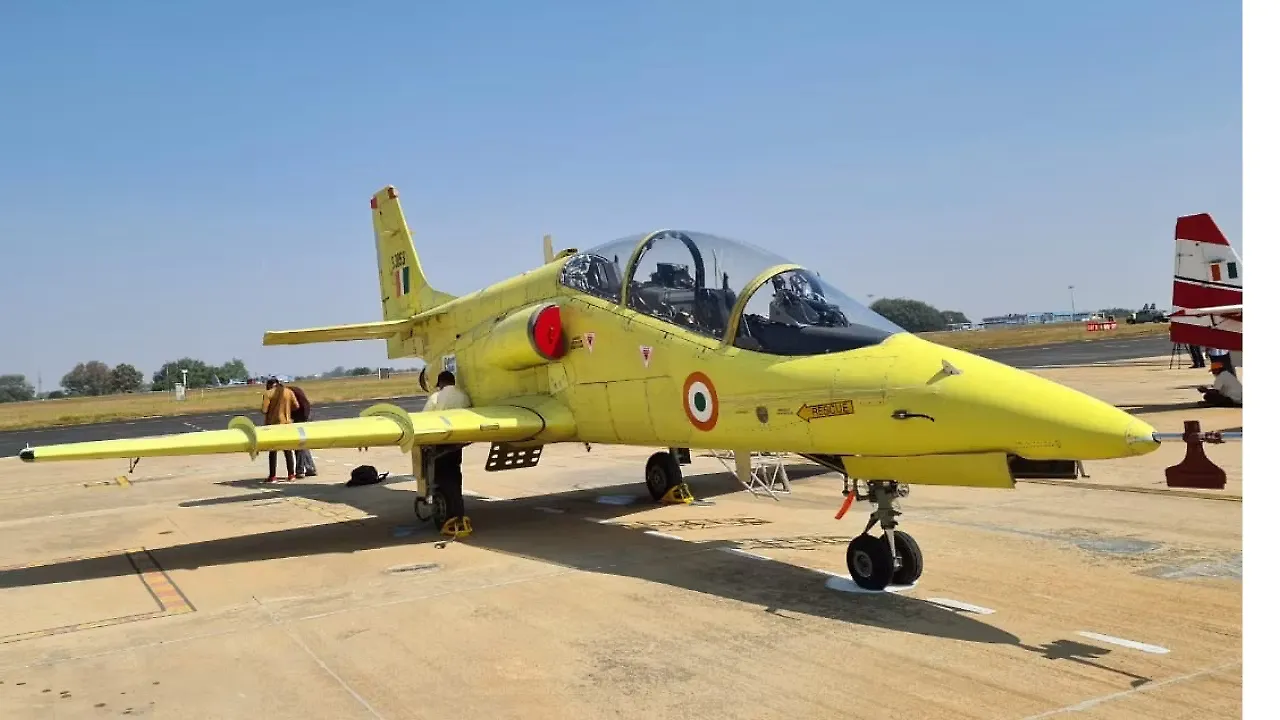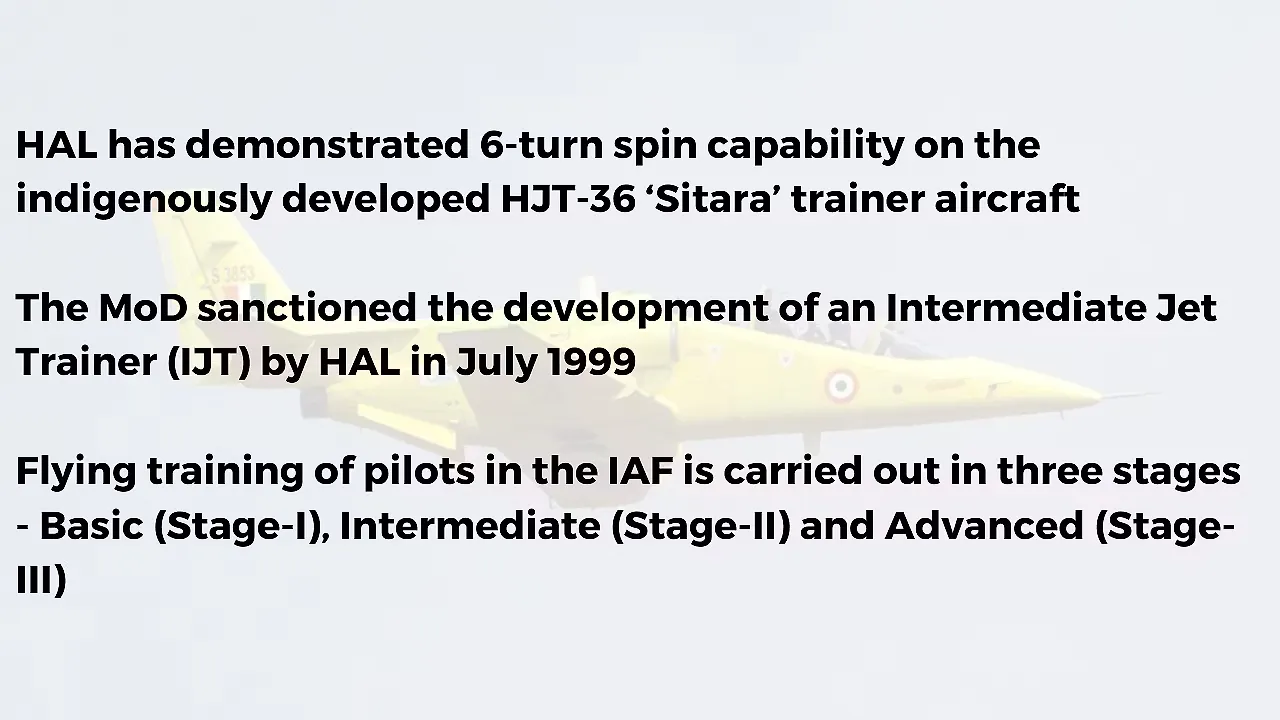
The recent announcement by Hindustan Aeronautics Limited (HAL) of its successful demonstration of 6-turn spin capability on the indigenously developed Hindustan Jet Trainer 36 (HJT-36) ‘Sitara’ trainer aircraft suggests that the airframer has resolved several issues plaguing the long-delayed programme.
The recent tests saw an HJT-36 prototype piloted by Gp. Capt HV Thakur (Retd) and Gp. Capt A Menon (Retd) demonstrated the aircraft’s ability to carry out six turn spins on the left and right side. HAL performed several test flights before carrying out the 6-turn spin flights, marking the beginning of a resolution to a problem that plagued the programme since 2016. HAL had restarted stall and spin testing on the HJT-36 in a newly modified configuration in November 2020.
Testing Times
The development of an Intermediate Jet Trainer (IJT) was sanctioned by the Ministry of Defence (MoD) in July 1999 at INR 180 crore with a completion date of July 2004. Nearly 23 years later, the air force has to receive an IJT to replace its obsolescent HAL built Kiran MkI and MkII jet trainers. Flying training of pilots in the IAF is carried out in three stages - Basic (Stage-I), Intermediate (Stage-II) and Advanced (Stage-III).
Basic training is undertaken on a fleet of 75 Swiss Pilatus PC-7 MKII turboprop trainers, while intermediate and advanced flight training is conducted on built Kiran MkI, Mk IIs, and BAE Systems Hawk Mk132 Advanced Jet Trainers (AJT), respectively. Since the seventies, the air force has been using Kiran aircraft in the training role.
In addition to clearing the HJT-36 as an airborne trainer, HAL will also have to offer a complete simulation-based training solution for the IJT to match the IAF’s infrastructure already set up for its PC-7 MKII and Hawk Mk132 fleets. The IAF has now made it mandatory for all new aircraft procurements to include Fixed Base Full Mission Simulators (FBS), Cockpit Procedure Trainers (CPT), Avionics Part Task Trainer (APTT), Flight Training Devices (FTD) and computer-aided learning systems. This could prove a challenging endeavour for HAL.
The HJT-36, developed by HAL’s Aircraft Research & Development Centre (ARDC), had stalled in 2016 over the prototype’s unsatisfactory spin testing characteristics when the aircraft departed from controlled flight. Over the last six years, HAL had to resort to major modifications like shifting the vertical tail aft on the airframe and increasing the rudder area before resuming flight testing in April 2019. To ensure the safety of the flight test crew and aircraft, HAL installed a new Anti-Spin Parachute system (ASPS) on the aircraft in July 2020 and demonstrated successful streaming of the parachutes in September 2020.

During an aircraft’s development, spin and stall testing on prototype aircraft is undertaken by a highly experienced test crew. However, the plane after certification will be flown by trainee pilots, who will require training to enter and recover from a stall or spin to recognise an aircraft’s departure from controlled flight and then perform the correct actions necessary to recover from such situations. Hence, a trainer aircraft must demonstrate its ability to recover from a spin or stall situation safely and consistently.
Change of Heart
The HJT-36 programme has also suffered due to a change in the powerplants selected for the single-engine trainer. The non-freezing of the engine at the initial change, change in engine weight and experimenting with engines of inadequate thrust have all contributed to delays to the programme.
The first HJT-36 prototype flew in March 2003, powered by a Snecma (now Safran) Larzac 04H20 engine and PT-2 took to the air a year later in March 2004. The Larzac 04 is a two-shaft turbofan engine developed between 1969 and 1973.
In April 2005, HAL contracted Russia’s NPO Saturn (now United Engine Corporation) for the higher thrust AL-551 engine for the HJT-36. The AL-55I turbojet engine, which currently powers the HJT-36, was specially designed for the trainer aircraft and generated a maximum thrust of 3,880 lb. As a result, the engine’s service life gradually increased from 100 to 300 hours, then to 600, 900 and now at 1,200 hours.
Delayed Development
The IAF first identified the need to replace its ageing HAL built Kiran and Polish Iskara aircraft in March 1998, and the latter was phased out from service in 2004. The MoD’s project sanction to HAL for INR 180 crore also included the production of two prototypes. The initial developmental cost of INR 180 crore was revised to INR 467 crore in April 2005.

Despite the delays associated with the programme, the IAF concluded a contract with HAL in March 2006 to supply 12 Limited Series Production (LSP) aircraft at a total cost of INR 486 crore. These aircraft were originally to have been delivered between March 2008 and March 2010. The IAF then went to order 73 Series Production (SP) aircraft at a total cost of INR 6,180 crore in March 2010, with deliveries to take place between 2013-2017.
Accidents to both prototypes during flight testing early in the programme resulted in the suspension of flight test activities and modifications for strengthening the aircraft’s structure. These steps further delayed the programme. The first HJT-36 prototype aircraft PT-1, met with an accident at Aero India in 2007, when a failure of its canopy locking system resulted in the aircraft going off the runway. The accident resulted in major damage to PT -1’s wings, empennage and landing gear. PT-1 was repaired and resumed flying but later met with another accident in April 2011. The second prototype aircraft (PT-2) met with an accident at Aero India 2009, when its landing gear failed during a practice sortie before Aero India 2009.
It is hard to imagine in the commercial world that a product first conceptualised two decades ago would still remain relevant at the present time. While HAL has invested significant time and effort to restart the HJT-36’s development, it remains to be seen if the aircraft can make the transition from a development programme to delivering on the air force’s two-decade-old requirements for an intermediate jet trainer.